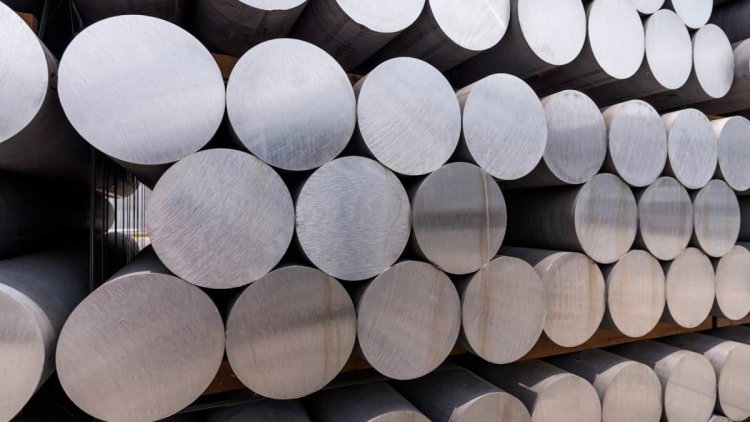Aluminum’s Booms and Busts: Is More Volatility Ahead?
The growth of the EV market means more aluminum used to manufacture cars. Some models use twice as much as standard autos. “It's really a huge leap."

The growth of the EV market means more aluminum used to manufacture cars. Some models use twice as much as standard autos. “It's really a huge leap."
Aluminum demand has soared this year, with prices hitting an all-time high in March, as the post-pandemic consumption boom saw heavy demand for electric vehicles, appliances, and renewable-energy equipment, which use the silver-gray metal as components.
Amid such demand and price volatility, futures traders are rushing to manage price risk. Demand is so brisk that CME Group saw physical aluminum trading volume tripled from Q1 to Q3 2022 with a record 3,700 contracts changing hands daily.
To further develop the business, the CME in October teamed with financial services firm Marex to expand its clients’ access to its base metals suite.
“Clients have come to us asking for a viable alternative to manage risk in the aluminum space and overall base metals industry," Jin Chang, managing director and global head of metals at CME, said during a recent Open Markets Exchange of Ideas panel. "Volatility is here to stay and we need appropriate risk management tools to manage it as well as transparency around price discovery.”
Andy Massey, vice president of metals, procurement, and transportation at U.S.-based Bonnell Aluminum, added that EV demand remains high, fueling current and future uptake for the lightweight metal. "The aluminum market is exploding right now," he noted. "We are getting more and more aluminum used in cars. We used to get excited about 300 pounds per vehicle but with some of the EV models, we are getting 500 to 800 pounds. It's really a huge leap."
$240 Billion Market
Purchases of aluminum--which is also used to make airplanes and renewable energy equipment such as wind towers or solar panels--remain strong in the United States though they have softened in Europe and China, Massey added. Europe has been hurt by the Russia-Ukraine war and soaring energy prices while China continues to be negatively impacted by its strict zero-covid policy as well as droughts hitting key production hubs.
Overall, however, growth is expected to remain healthy with the base metal’s sales forecast to hit $238 billion by 2028, up from $142 billion last year, according to a report by SkyQuest Technology Consultancy.
"Long-term, the aluminum metals outlook is good,” added Chang. “This is because it's a key ingredient in the clean energy transition while aluminum and copper are also very important components in electric vehicles."
The car industry is the world’s largest aluminum consumer, churning out nearly 67 million vehicles per year, according to SkyQuest. China is the biggest producer, accounting for 60% of production, followed by Russia and then Europe and the U.S. The world made 68.9 metric tons of aluminum in 2022 as of October, according to a report by ING.
'Borrowing From the Future'
As the world faces a potential recession (the International Monetary Fund recently cut its global growth outlook to 2.7% from 3.8% in January), fears of a global supply glut are growing, however.
Jorge Vazquez, the founder of leading consultancy Harbor Aluminum, sees excess inventory as a growing risk. Already, demand is beginning to ease so pandemic-induced oversupplies could soon struggle to find a home, squeezing margins and forcing producers to slash prices.
“During the pandemic, consumers bought new homes, boats, motorcycles, and even washing machines, all of which are aluminum-intensive goods,” Vazquez told Chang in a recent interview. “In a 12-month period, we bought more than we would have purchased in a three-year span. In other words, we borrowed demand from the future.”
That, argued Vazquez, will sap consumption and derail prices in coming months. With higher interest rates and a lack of economic stimulus, “things will get a bit more complicated,” he added.
Watch the full interview with Vazquez in the video above.
Sanctions Impact?
Asked how a new round of U.S. sanctions on Russia could impact the sector, Vazquez said a repeat of the 2018 regime would send prices surging.
“If for any reason the U.S. sanctions Russian aluminum, if they repeat what they did in 2018 when U.S. and non-U.S. persons were banned from buying or serving companies outsourcing Russian aluminum, the price and premiums would skyrocket,” he explained. “However, if the U.S. just bans Russian aluminum in the U.S. or hikes duties, because we import so little from Russia, the impact will be immaterial in price and premiums.”
In 2018, when Washington imposed levies on Russian aluminum major Rusal, the event sent prices soaring.
“Initially (soon after Russia’s invasion), the fear of sanctions was real but the market has moved on from that,” says Guy Wolf, global head of market analytics at Marex. “The experience from 2018 when the U.S. imposed sanctions on Russian aluminum was that the only people hurt were domestic consumers. U.S. car companies suddenly found themselves at a massive cost disadvantage.”
What to Watch
Meanwhile, the panelists discussed some of the key events to watch in 2023.
“If I had to pick one thing, I would watch (the) production of base metals including aluminum, and look at demand to see where it’s going…,” said Massey. “I question if the economy will be as bad as expected next year and if there will be a surplus at all.”
For his part, Wolf said he will monitor prices. “I would look at inflationary expectations,” he said. “Central Banks are slightly mistaken in thinking the recent inflation problem is because demand is too strong. Inflation is high because of the one-off energy shock of the Ukraine situation.”
What's Your Reaction?



























































